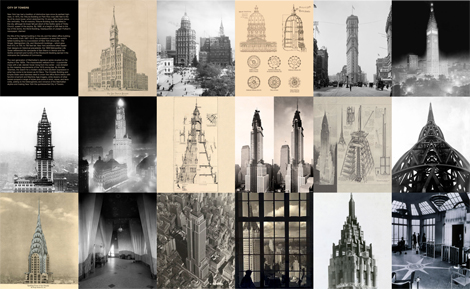The Skyscraper Museum is devoted to the study of high-rise building, past, present, and future. The Museum explores tall buildings as objects of design, products of technology, sites of construction, investments in real estate, and places of work and residence. This site will look better in a browser that supports web standards, but it is accessible to any browser or Internet device.
CITY OF TOWERS

New York has had a tradition of distinctive tops since its earliest high-rises. In 1875, the Tribune Building on Park Row rose 260 feet to the tip of its clock tower, which stretched the 10-story office block below into verticality. The all-masonry Tribune Building was the tallest in the city, although its tower fell just short of the Gothic spire of Trinity Church, queen of the skyline.
By 1890, at a height of 309 feet to the top of the dome, the World Building, headquarters of Joseph Pulitzer’s newspaper, claimed the title of the highest building in the city and the tallest office building in the world. From 1907-1913, the competition to erect the world’s tallest building led to a succession of New York structures – the Singer, Metropolitan Life, and Woolworth buildings – which grew from 612, to 700, to 792 feet tall. New York architects often based their designs on historical precedents: the 1909 Metropolitan Life Tower referenced the campanile of San Marco in Venice and the Gothic ornament and turrets of the Woolworth Building earned it the nickname the Cathedral of Commerce.
The next generation of Manhattan’s signature spires erupted on the skyline in the 1920s. The characteristic setback form – a pyramidal mass with a tall, slender tower rising from the center – was dictated by the massing requirements of the 1916 zoning law. By the late Twenties, the search for a modern style found ebullient expression in what has come to be known as Art Deco. The Chrysler Building and Empire State used stainless steel to crown the office floors below with fanciful ornament and Machine-Age imagery, while dozens of other towers arrayed a range of styles and colors in brick, stone, and terra cotta, adding to the heterogeneity and romance of the Manhattan skyline and making New York the quintessential City of Towers.
